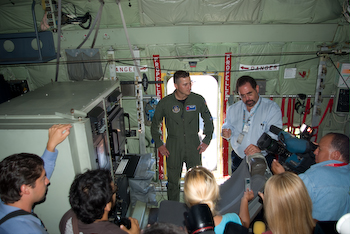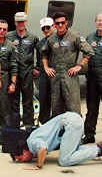Tips for the Media

If you’re a bona-fide member of the media, you may get permission to fly on one of our storm missions.
Call our 403rd Wing Public Affairs office at (228)377-2056 during normal office hours (8 a.m.- 4:30 p.m. Central time) when there is a storm going on.
Please call as soon as possible, because our flights fill up fast–especially when the storm approaches land.
We can take up to three media outlets at a time.Please limit the number of people you send to two. If you’d like to film on a training (non-storm) flight, please allow 2 to 3 weeks to coordinate permission.
Equipment Recommendations:
Bring plenty of spare batteries. We do not have a power source to recharge on the airplane.
If recording sound, consider a small remote (peanut or lapel) microphone which can be placed inside your headset (we’ll loan a headset, which you may need to share). It’s about 110 decibels inside the plane, and the headset is about the only way to be heard and understood. A hand-held microphone works well for you to provide commentary without interrupting the crew. A camera-mounted microphone doesn’t work as well as a hand-held microphone.
If you’re lucky enough to fly into a well-formed hurricane eye, (most do not show the “stadium effect”)a wide-angle lens works well. Some excellent video has been taken with a lipstick camera up against a window (with a suction cup).
Some polarizing lenses pick up interference from our windows, so look out for the “rainbows”.
Radio-transmitting (wireless) microphone systems have been known to fail inflight, possibly due to interference with aircraft radios. We suggest using or at least bringing cables.
Please be aware that if any of your equipment interferes with the aircraft’s electronic systems, you’ll be advised to stop operation.
Transportation Rules:
You’re on your own for transportation to and from the airbase(s)
There is no guarantee that we’ll land at the same base from which we departed –usually we know ahead of time, but not always
If we land at a different base, you’ll need to arrange your return trip from there
We normally don’t take passengers if we’re scheduled to fly out of the U.S. Our Public Affairs Office must receive special permission from the foreign desk in Washington D.C.
Liability:
We have an outstanding safety record, but we’ll still have each passenger sign a standard release form. This is required before you board the flight.

Understand that we will be flying through thunderstorms, with severe turbulence, hail, and lightning possible–but not guaranteed.
In the end, many media folks are disappointed their flight wasn’t more “exciting”, but…
BE CAREFUL WHAT YOU WISH FOR!
Medical:
We don’t recommend folks fly with head colds because of the danger of an ear or sinus block. Epileptics have had seizures in flight. Consult with your physician if you have any medical concerns. We do not carry any medications on board the aircraft, not even aspirin, decongestants or airsickness pills. These are all up to you. Most of our guests do not encounter problems with airsickness, but please do not be embarrassed if you don’t feel well (for ANY reason)–let a crewmember know so we can help. We’ll hand out airsickness bags at the beginning of the flight, but please don’t feel we expect you to use ’em!
Hydration:
Dehydration is a serious concern in the hot/humid climates we operate from, compounded by the dry air inflight. Please restrict alcohol, coffee, or sugar-laden drinks: water is your best choice. Don’t wait until you’re thirsty, because then its too late.
Food:
We recommend you have a light meal prior to flying–stomachs seem to do better with some food in ’em. Bring food– this may be a 10-12 hour flight. We provide coffee and water. There is a small convection oven on board for heating up TV dinners (which usually works), and we also have a hot pot to boil water for soups, tea, etc. We do not have any refrigeration on board, so bring non-perishable foods or else a cooler with ice.
Clothes:
Bottom line: comfortable! Flat, comfortable shoes or boots. Sunglasses for viewing the storm out the window. If wearing short sleeves, you may want a light jacket for the higher-altitude flight to and from the hurricane. Bring enough funds, personal items, professional equipment/supplies to be self-sufficient for a number of days. A small pillow for a nap.
Special consideration for Winter Storm flights: Think cold, not tropical, when dressing for a winter storm flight. Long pants and consider some long underwear. It is -50 degrees up at the altitudes we’ll reach, and the aircraft is not always well insulated, especially near the floor. So dress in layers, and pay attention to your feet. There are parts of the airplane that are colder than others, but you want to be prepared so you can spend some time in a colder section.
Arrival Instructions:
Our crews normally meet about two hours prior to takeoff. We would like you there by that time, and perhaps a bit earlier if you would like to set up any equipment to record the premission briefing. We’ll give you the time and place to meet. For travel planning, the nearest airports are Gulfport-Biloxi Regional (30 minutes away), New Orleans, LA (90 minutes away), and Mobile, AL (1 hr away).
Media Escort:
You’ll be accompanied by an escort who will help make this a smooth experience for you. The escort will arrange time for you to visit the flight deck (you may have to take turns with another media rep, if this is a popular flight), and let you know when the crew has time to answer questions. Most escorts have experienced several hurricane flights themselves, and can answer many of your questions when the crew is busy.
CAVEAT:
You may ask any questions you wish, but please be aware that WE cannot make forecasts, such as “where is the storm going?” or “what’s it going to do?”. That’s the job of the Hurricane Specialists at the National Hurricane Center, who will use our weather data, plus data from many other sources and computer models to make these very difficult forecasts. It’s also not prudent to extrapolate from what we see on any single flight: the storms fluctuate in strength and sometimes wobble in their paths, and the experts at the Center need to decipher what these short-term changes mean. There are many lives and millions of dollars at stake, so please refer to the official forecast to answer these questions–as do we!
Live Feeds:
It may be possible to conduct a live (audio only) interview via HF-radio phone patch. However, the timing needs to be flexible (schedule several potential windows), since the patches may not be possible if the crew is too busy with the mission at that time, the atmospherics are poor, the plane is passing through heavy rain, or other airplanes are using the frequency. We also cannot stay “on hold” for more than a couple minutes, due to other aircraft needing to use the radiophone frequencies. The quality of the sound is also often poor, due to the atmospherics, so we’re not encouraging phone patches.
Pool Footage:
In the past, some media organizations have arranged to get copies of footage shot by others on our flights. This is entirely between you and the reporters on the flight. We do not personally have any public-domain footage. We have a list of a few companies that have flown with us and have footage that may meet your needs.
The Finished Product:
We request a copy of your article or video for our archives. When our Public Affairs Office receives your product, they will send you an authentic “Hurricane Hunter” certificate. Thank you for flying “Teal” Air!
